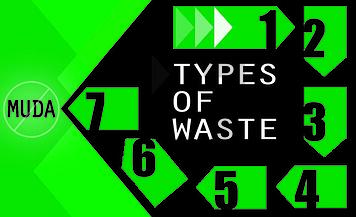 The foundational philosophy behind lean manufacturing is to eliminate waste. It’s not to work faster or better, it’s to eliminate waste of any kind that’s not adding value.
The foundational philosophy behind lean manufacturing is to eliminate waste. It’s not to work faster or better, it’s to eliminate waste of any kind that’s not adding value.
To be sure, one of the benefits of eliminating waste in the manufacturing process is being able to work faster and better. If you approach a problem with a “do it faster, do it better” attitude, you may mask the symptoms, but you won’t get to the root of the problem.
Lean manufacturing is designed to help manufacturers reduce costs and increase productivity by getting to the very root of a problem. We do that by eliminating the muda.
Muda is a Japanese term that means “waste.” Since lean manufacturing was originally a Japanese management philosophy, we often borrow Japanese terms and concepts. According to lean manufacturing principals, there are 7 mudas or seven types of waste that can be found in a manufacturing process.
- Overproduction: A “just in case” mindset can often lead to overproduction or storing of extra products, which wastes storage space and production time and energy. You also have a problem if the customer decides later that they don’t want the item anymore, or there are ordering delays and the product spoils before delivery.
- Inventory: This is the other side of the “overproduction” coin. If you order extra raw materials so they’re available “just in case,” that’s also wasteful. The order specs may change, food products may get wasted, or again, the customer may not want the product anymore.
- Defects: Defects and broken products can lead to customer dissatisfaction, and you spend extra time and money solving the problem, reworking the items, or paying for the customer to dispose of the waste. Shipping damage is also considered a defect.
- Processing: Also called over-processing, this is where companies expend more energy to produce their items through wasted movement and time. This could be a result of extra/unnecessary manufacturing steps, using older and outdated methods, or not having standard work plans.
- Motion: Unnecessary motion can happen as a result of an inefficient process, a lack of standardized procedures, or even a lack of training for employees. Wasted motion is a hidden cost because it’s not something we can easily see, but only through careful observation and communicating with the workers.
- Transport and Handling: The thing we see the most, since it’s our job, is shipping damage. But this muda is much more than that. It includes pallets not being properly stretch wrapped (wasted material), or a truck is not loaded to use floor space efficiently. Even in handling, it can be something as simple as forklift drivers who need to climb off and on the forklifts to set up or fix a stretch wrapping machine or using a pallet jack to hand deliver pallets to the stretch wrapping machine – all wasted motion.
- Waiting: These are bottlenecks in time, usually due to broken machinery, lack of trained staff, shortages of materials, inefficient planning, or as a result of the six other mudas. At their worst, they can lead to slowed production, delayed shipments, and even missed deadlines. At the very least, this is time that is paid for but unproductive; you’re paying people to sit and wait.
There are other types of waste we’ve seen mentioned in other places — confusion (misinformation) and underutilization of available skills and knowledge, for example — but these are the original seven types of waste discussed in lean manufacturing principals. Eliminating these can be a long and difficult task, but they will go a long way in improving productivity and increasing profits.
Looking for other ways to improve? Learn 5 action steps that every shipping manager and plant manager should know to make loading docks run faster and safer. Download your FREE copy of The Lean Loading Dock.
Click here to read a related blog: Four Lessons Ernest Hemingway Teaches Us About Lean Manufacturing
This post was published on August 7, 2013 and updated on November 28, 2018.
August 7, 2013

